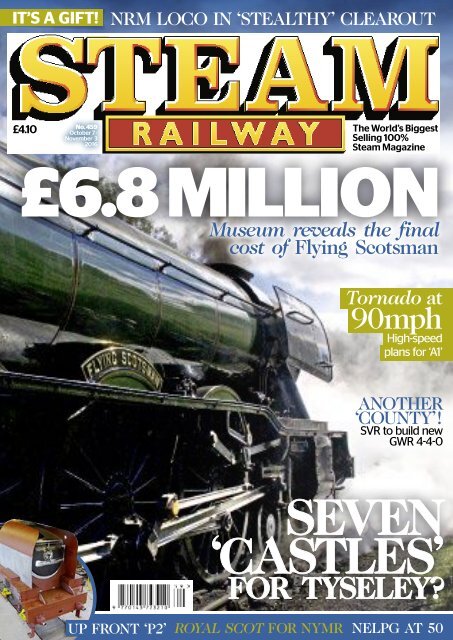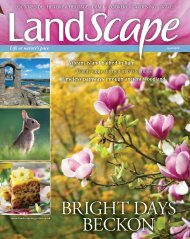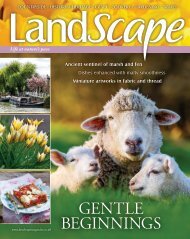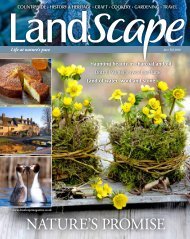Steam Railway Mini Magazine
You also want an ePaper? Increase the reach of your titles
YUMPU automatically turns print PDFs into web optimized ePapers that Google loves.
IT’S A GIFT!<br />
NRM LOCO IN ‘STEALTHY’ CLEAROUT<br />
£4.10<br />
No. 459<br />
October 7 -<br />
November 3<br />
2016<br />
The World’s Biggest<br />
Selling 100%<br />
<strong>Steam</strong> <strong>Magazine</strong><br />
£6.8 MILLION<br />
Museum reveals the final<br />
cost of Flying Scotsman<br />
Tornado at<br />
90mph<br />
High-speed<br />
plans for ‘A1’<br />
ANOTHER<br />
‘COUNTY’!<br />
SVR to build new<br />
GWR 4-4-0<br />
SEVEN<br />
‘CASTLES’<br />
FOR TYSELEY?<br />
UP FRONT ‘P2’<br />
ROYAL SCOT FOR NYMR<br />
NELPG AT 50
InTheWorks<br />
LONG TERM RESTORATION PROJECTS<br />
SWANAGE<br />
S&D STAR RISES AGAIN<br />
<strong>Steam</strong> <strong>Railway</strong> brings you the latest progress on<br />
the youngest preserved Bulleid ‘Pacific’<br />
Enthusiasts may view<br />
the Somerset & Dorset<br />
through rose-tinted<br />
spectacles, but it wasn’t<br />
always so pleasant for<br />
footplate crews, as Peter Smith relates<br />
in his books Mendips Engineman and<br />
Footplate over the Mendips.<br />
In one of the most dramatic<br />
sequences, he graphically recalls<br />
the terrifying pyrotechnics<br />
when ‘West Country’ No. 34105<br />
Swanage blasted half its fire<br />
out through the chimney in an<br />
almighty slip inside Devonshire<br />
Tunnel, while simultaneously<br />
trying to asphyxiate him and his<br />
driver Donald Beale in the narrow<br />
single‐line confines. Like Ivo Peters’<br />
narrow escape from a blowback (see<br />
pages 62-63), it’s a sobering reminder<br />
of the harnessed power, and the<br />
dangers, of the steam locomotive.<br />
As the S&D’s most important<br />
anniversary rolls around, things are<br />
more serene for No. 34105. It’s been<br />
out of action at the Mid-Hants <strong>Railway</strong><br />
for almost two decades, but with an<br />
overhaul well under way, the youngest<br />
surviving Bulleid ‘Pacific’ will soon be<br />
once again climbing through delightful<br />
scenery on a single-track crosscountry<br />
route.<br />
Well-earned TLC<br />
Life for Bulleids on the S&D was pretty<br />
hard, with tales of valve gear chains<br />
stretched on the gruelling banks and<br />
oil-soaked boiler lagging set alight by<br />
hot brake blocks on the long descents,<br />
but retirement wasn’t exactly sedate<br />
for Swanage either. First steamed<br />
in 1987 after an 11-year restoration<br />
from Barry condition (during which<br />
Donald Beale visited for a reunion),<br />
it completed a full ‘ten-year’ boiler<br />
ticket before being ‘stopped’ due to the<br />
condition of its axleboxes. When asked<br />
what needed doing to the ‘bottom<br />
half’ this time, Project Manager Steve<br />
Humby replies simply: “Everything.”<br />
“It’s fairly well-documented that<br />
there were problems with the track<br />
on the Alton extension when it first<br />
reopened,” he elaborates, “and that<br />
gave it quite a hammering.<br />
“All the horn guide liners had<br />
worked loose - they’re secured<br />
by one bolt while the<br />
rebuilds had six. The horns<br />
were worn, and we’ve built<br />
them up with weld.”<br />
Like many ex-Barry<br />
engines in their first<br />
‘ten-yearly’, he describes<br />
it as “the first major<br />
Swanage at its namesake town.<br />
No. 34105 makes a striking<br />
presence on shed at the branch<br />
terminus, during its visit to the<br />
Swanage <strong>Railway</strong> on March 20<br />
1993. J.R. BAGSHAW<br />
DID<br />
YOU KNOW..?<br />
A crest was originally<br />
produced for No. 34105,<br />
incorporating the<br />
Swanage coat-of-arms, but<br />
never fitted - until 1993,<br />
when the locomotive<br />
visited the Swanage<br />
<strong>Railway</strong>.<br />
No. 34105’s frames<br />
and cab inside Ropley<br />
works on March 1.<br />
overhaul since BR days - they were<br />
done on a shoestring first time,<br />
but now we’ve got the benefit of<br />
more experience and far better<br />
facilities.”<br />
Attention is currently focused<br />
on the centre cylinder, and one<br />
defect which could date back<br />
to when it was built - wastage on<br />
the mounting faces for the main<br />
steam pipes: “City of Wells had the<br />
same problem, but none of the other<br />
Bulleids do - perhaps because these<br />
were in the last batch, the pattern was<br />
well-used to start with.”<br />
The contract has been placed for<br />
a new liner in the centre cylinder, and<br />
the outside ones have been rebored.<br />
{ NO. 34105 SWANAGE }<br />
Built:.................................Brighton, 1950<br />
To traffic:...........................Bournemouth, February 25 1950<br />
On September 6 1964:.....Eastleigh<br />
On October 4 1964:..........Withdrawn<br />
Arrived at Barry:...............February 1965<br />
Left Barry:.........................March 1978 (Departure No. 90)<br />
46 Issue 452 March 24-April 21 2016 www.steamrailway.co.uk
Asked what needed doing to the<br />
‘bottom half’ this time, Project<br />
Manager Steve Humby replies<br />
simply: “Everything”<br />
{ HOW YOU CAN HELP }<br />
Swanage was saved from Barry by a group of MHR members who<br />
had originally set their sights on Stanier ‘8Fs’ Nos. 48518 and 48624.<br />
Today, the MHR Preservation Society is a significant shareholder and<br />
is funding the current overhaul; donations payable to MHRPS can be<br />
sent to the <strong>Railway</strong> Station, Alresford, Hampshire SO24 9JG, or made<br />
online at www.watercressline.co.uk<br />
The driving, bogie and delta truck<br />
wheels have had their tyres turned at<br />
the South Devon <strong>Railway</strong>, while the<br />
tender may need complete retyring.<br />
The famous oil bath and chaindriven<br />
valve gear are in bits: “The<br />
chain was new at the first restoration<br />
- most lost them at Barry - and it isn’t<br />
the original type, so we had to change<br />
the sprockets on the drive wheels.<br />
Only later did other groups persuade<br />
Morse [the original manufacturers] to<br />
start producing it again.”<br />
Underneath the firebox, the frame<br />
doubling plates were removed to clear<br />
corrosion between them and the<br />
frames themselves, and the distorted<br />
frames were straightened by Phil<br />
Candy, a former Eastleigh blacksmith.<br />
The smokebox, casing and cab<br />
sheeting will be all-new, thanks not<br />
only to outdoor storage but, ironically,<br />
to cleaning: “The casing was rusting<br />
even before it came out of service<br />
because it had been done with car<br />
wax and soapy water. Wadebridge has<br />
been cleaned with paraffin, and the<br />
oil content protects it.” A lesson there,<br />
perhaps - clean your engines the BR<br />
way, and not only will they look more<br />
authentic, you might save money on<br />
the next overhaul?<br />
What will also be more authentic is<br />
the tender - originally from ‘Merchant<br />
Navy’ No. 35025 Brocklebank Line. To<br />
offset the effect of the longer chassis,<br />
it was given the high-sided ‘raves’ -<br />
dictating BR green with the ‘cycling<br />
lion’ crest - but while replacing the<br />
inner bracing, the opportunity has<br />
been taken to correct the radius of<br />
the top curve and the shape of the<br />
coal space. The latter isn’t just rivetcounting:<br />
“Because the sides were too<br />
steep, and back then we did an extra<br />
round trip each day, it would run out<br />
of coal!”<br />
Check every corner<br />
If the ‘bottom end’ was well-worn, the<br />
boiler held fewer horrors. Thanks to<br />
effective water treatment, the barrel is,<br />
according to boiler shop foreman Andy<br />
Netherwood: “superb - it’s got marginal<br />
corrosion on the outside, but the inside<br />
Top: Looking up<br />
inside Swanage’s<br />
firebox towards the<br />
tubeplate, showing the<br />
thermic siphons and<br />
their diaphragm plates<br />
on the throatplate, due<br />
for replacement.<br />
One of the<br />
foundation ring<br />
corners removed for<br />
replacement, showing<br />
where a crack was<br />
welded up in BR days.<br />
is as good as the day it was built.<br />
“Because there are so many<br />
Bulleids in preservation, we know<br />
where to expect problems, but this<br />
one hasn’t proved to have any serious<br />
defects.”<br />
The biggest trouble spot on O.V.S.’s<br />
‘Pacifics’ is the thermic siphons - the<br />
arch tubes connecting the firebox<br />
throatplate to the crownsheet. These<br />
improve water circulation and provide<br />
additional heating surface, but can be<br />
a headache at overhaul time - usually<br />
needing new sections welding in on<br />
the undersides. Swanage has already<br />
had this done in BR days and requires<br />
it again, as well as replacement of<br />
the diaphragm plates connecting the<br />
siphons to the throatplate.<br />
Another maintenance trade-off<br />
comes with the firebox foundation<br />
ring, which consists of a U-shaped<br />
channel instead of the thick steel<br />
casting found on most engines. As well<br />
as saving weight, this was intended<br />
to reduce stress from expansion and<br />
contraction - but still suffers from<br />
cracking in the corners. One of these,<br />
Andy points out, had already been<br />
welded by BR, through the washout<br />
plug above it - but all four corners will<br />
now be replaced with new pressings<br />
ordered from Buckfastleigh (which is<br />
also making the new siphon sections).<br />
The firebox tubeplate is to be<br />
replaced, but the smokebox tubeplate<br />
is acceptable for re-use, and Andy<br />
says: “Virtually none of the firebox<br />
plate needs replacing - there’s less<br />
cracking than we expected, and what<br />
there is we can weld up in situ.”<br />
‘Spam’ shortage<br />
Working in parallel with the boiler of<br />
Urie ‘S15’ 4‐6‐0 No. 506 - now the main<br />
job in hand after the boiler from ‘4MT’<br />
2‐6‐0 No. 76017 was steam-tested in<br />
February - Andy estimates that there is<br />
another 18 months’ work on Swanage’s<br />
boiler, while Steve reckons that the<br />
frames are a year from rewheeling.<br />
With fellow ‘Spam Can’ No. 34007<br />
Wadebridge having reached the end of<br />
its ‘ticket’, this Southern Region time<br />
warp now faces the prospect of being<br />
without a working Bulleid. It’s good to<br />
know that it won’t be for too long, and<br />
the return of Swanage - and Canadian<br />
Pacific in 2018 - will be very welcome.<br />
www.facebook.com/<strong>Steam</strong><strong>Railway</strong><br />
March 24-April 21 2016 Issue 452 47
Gallery<br />
The best in steam photography
LBSCR ‘E4’ 0-6-2T<br />
No. B473 recreates a typical<br />
Southern branch train for a<br />
75H charter at the Bluebell<br />
<strong>Railway</strong> on March 17.<br />
GREG COOMBER<br />
Far left: ‘A1’ No. 60163<br />
Tornado and GWR ‘Mogul’<br />
No. 5322 inside Didcot shed<br />
during a Timeline Events<br />
night shoot on March 26.<br />
JACK BOSKETT<br />
GWR ‘56XX’ 0-6-2T<br />
No. 5643 leaves Bolton<br />
Abbey station and enters<br />
Hambleton cutting on<br />
December 13 2015.<br />
ANDREW RAPACZ<br />
Below left: Metropolitan<br />
<strong>Railway</strong> 0-4-4T No. 1<br />
reaches the end of the<br />
rainbow at Hammersmith,<br />
on the Midland <strong>Railway</strong><br />
- Butterley on March 27.<br />
SIMON BEEDIE
<strong>Railway</strong>men at<br />
In a follow-up to our popular feature ‘Engineers at Rest’ in SR451,<br />
TOM BRIGHT uncovers the final resting places of more of this<br />
country’s most prominent railwaymen<br />
Did you know that the death of<br />
one chief mechanical engineer<br />
indirectly led to the death of<br />
another? As part of <strong>Steam</strong><br />
<strong>Railway</strong>’s ongoing study of<br />
the final resting places of our most eminent<br />
engineers, the tragic tale of Massey Bromley<br />
and Charles Reboul Sacre came to light.<br />
Bromley’s tenure as CME of the Great<br />
Eastern <strong>Railway</strong> only lasted three years, and<br />
none of his locomotive designs survived into<br />
LNER ownership. He was killed, along with<br />
23 others when, at Penistone in 1884, while<br />
travelling on the 12.30pm Manchester-King’s<br />
Cross service, the locomotive’s crank axle<br />
snapped and the train derailed.<br />
The engine, Manchester, Sheffield &<br />
Lincolnshire <strong>Railway</strong> ‘D12’ 4‐4‐0 No. 443, was<br />
designed by MS&LR CME Charles Reboul<br />
Sacre. While no blame could be apportioned<br />
to him or his design, Sacre reportedly felt such<br />
overwhelming guilt that he committed suicide<br />
by shooting himself five years later.<br />
By commemorating CMEs, we overlooked<br />
innumerable others who played their part in<br />
developing the railways. One such man was<br />
Col Holman Fred Stephens, best known for<br />
his light railways. SR reader Ross Shimmon<br />
explains Colonel Stephens’ importance: “He<br />
exploited the terms of the Light <strong>Railway</strong>s Act<br />
of 1896, intended to help rural communities<br />
by encouraging construction of railways<br />
where conventional ‘heavy’ railways would<br />
be unviable, and engineered or managed 16<br />
lines in England and Wales. He also designed<br />
several locomotives and experimented with<br />
unconventional motive power.”<br />
Col Stephens also extended the Welsh<br />
Highland <strong>Railway</strong> to Porthmadog from Rhydddu<br />
in 1923, the same year he became civil<br />
engineer and locomotive superintendent for<br />
both the WHR and Ffestiniog.<br />
Staying with these North Wales lines,<br />
another who adapted the steam locomotive<br />
for all types of use included Robert Francis<br />
Fairlie. His ‘Double Fairlies’ transformed the<br />
Ffestiniog, and not only is 1879-built Merddin<br />
Emrys still in service, but the railway is<br />
planning to build another; a testament to the<br />
quality of Fairlie’s innovative design.<br />
Equally innovative are the Beyer-Garratts,<br />
patented by Herbert W. Garratt in 1907. While<br />
the type was never widely adopted in Britain,<br />
former South African ‘NGG16s’ form the<br />
backbone of WHR passenger services today.<br />
Henry Greenly is most famous for his<br />
locomotive designs for the Romney, Hythe &<br />
Dymchurch <strong>Railway</strong>. Greenly’s one-third scale<br />
15in gauge ‘Pacific’ and ‘Mountain’ engines<br />
took inspiration from Gresley’s ‘A3s’ in 1927<br />
and still run today at speeds of up to 25mph -<br />
equivalent to 75mph in full-size terms. SR<br />
1. LAWSON BILLINTON<br />
(Locomotive Engineer)<br />
London, Brighton & South Coast <strong>Railway</strong> (1912-22)<br />
Born: 1882, Brighton, Sussex<br />
Died: 1954, Lyme Regis, Dorset<br />
Cremated: Weymouth Crematorium, Dorset<br />
2. JOHN BLENKINSOP<br />
(Pioneering Locomotive Engineer),<br />
Middleton <strong>Railway</strong> (1808-31)<br />
Born: 1783, Felling, County Durham<br />
Died: 1831, Leeds<br />
Buried: Holy Trinity Churchyard, Rothwell, Leeds<br />
3. THOMAS BOUCH (Bridge Designer)<br />
Born: 1822, Thursby, Cumberland<br />
Died: 1880, Moffat, Dumfries & Galloway, Scotland<br />
Buried: Dean Cemetery, Edinburgh<br />
4. MASSEY BROMLEY<br />
(Chief Mechanical Engineer)<br />
Great Eastern <strong>Railway</strong> (1878-81)<br />
Born: 1847, Leamington, Warwickshire<br />
Died: 1884, Penistone, South Yorkshire<br />
Buried: Leamington Cemetery, Warwickshire<br />
5. THOMAS EDMONDSON<br />
(Ticketing Innovator)<br />
Born: 1792, Stonewell, Lancaster<br />
Died: 1851, Meltonville, Manchester<br />
Buried: Friends’ Burial Ground, Mount Street,<br />
Manchester<br />
6. ROBERT FRANCIS FAIRLIE<br />
(Locomotive Engineer and Designer)<br />
Born: 1830, Glasgow<br />
Died: 1885, Clapham Common, London<br />
Buried: West Norwood Cemetery, London<br />
7. SIR SAM FAY (General Manager)<br />
Midland & South Western Junction<br />
<strong>Railway</strong> (1892‐99)<br />
Great Central <strong>Railway</strong> (1902-22)<br />
Born: 1856, Hamble-le-Rice, Hampshire<br />
Died: 1953, Awbridge, Hampshire<br />
Buried: All Saints Church, Awbridge, Hampshire<br />
8. SIR JOHN FOWLER (Civil Engineer)<br />
London Underground & Forth Bridge<br />
Born: 1817, Wadsley, Sheffield<br />
Died: 1898, Bournemouth, Dorset<br />
Buried: Brompton Cemetery, London<br />
9. HERBERT WILLIAM GARRATT<br />
(Locomotive Engineer and Designer)<br />
Born: 1864, London<br />
Died: 1913, Richmond, Surrey<br />
Buried: Municipal Cemetery, Richmond, Surrey<br />
Named after its designer, ‘A2’ No. 60525 A.H. Peppercorn stands outside Doncaster in ex-works condition on September 26 1959.<br />
The locomotive’s namesake is buried at St Wilfrid’s Church, Cantley, Doncaster. NORMAN PREEDY/RAIL PHOTOPRINTS<br />
10. HENRY GREENLY<br />
(<strong>Mini</strong>ature Locomotive Designer)<br />
Born: 1876, Birkenhead, Merseyside<br />
Died: 1947, Heston, Hounslow, London<br />
Buried: St Leonard’s Church, Heston, Hounslow<br />
44 Issue 455 June 17-July 14 2016<br />
www.steamrailway.co.uk
3<br />
CHIEF MECHANICAL ENGINEERS<br />
rest<br />
11. WILLIAM HEDLEY (Pioneering<br />
Locomotive Engineer)<br />
Born: 1779, Newburn, Tyne and Wear<br />
Died: 1843, Lanchester, County Durham<br />
Buried: St Michael and All Angels Churchyard,<br />
Newburn, Tyne and Wear<br />
12. SIR ARTHUR HEYWOOD (Engineer)<br />
Pioneer of 15in ‘minimum gauge’ railways<br />
Born: 1849, Denstone, Staffordshire<br />
Died: 1916, Duffield, Derbyshire<br />
Buried: All Saints’ Church, Denstone, Staffordshire<br />
13. GEORGE HUDSON (<strong>Railway</strong> Promoter<br />
- ‘The <strong>Railway</strong> King’)<br />
Born: 1800, Howsham, Yorkshire<br />
Died: 1871, London<br />
Buried: St Peter & St Paul Churchyard,<br />
Scrayingham, North Yorkshire<br />
14. JOSEPH LOCKE (Civil Engineer)<br />
Born: 1805, Attercliffe, Sheffield<br />
Died: 1860, Moffat, Dumfries & Galloway, Scotland<br />
Buried: Kensal Green Cemetery, London<br />
15. MATTHEW MURRAY (Pioneering<br />
Locomotive Manufacturer)<br />
Born: 1765, Newcastle upon Tyne<br />
Died: 1826, Leeds<br />
Buried: St Matthew’s Churchyard, Holbeck, Leeds<br />
16. SIR HENRY OAKLEY (Great Northern<br />
<strong>Railway</strong>)<br />
Company Secretary (1858-70)<br />
General Manager (1870-98)<br />
Director, (1897-1912)<br />
Born: 1823, Marylebone, London<br />
Died: 1912, Regent’s Park, London<br />
Buried: Brompton Cemetery, London<br />
17. SIR CECIL PAGET (General<br />
Superintendent, designer of the ‘Paget Locomotive’)<br />
Midland <strong>Railway</strong> (1907-19)<br />
Born: 1874, Sutton Bonington, Nottinghamshire<br />
Died: 1936, King’s Newton Hall, Derbyshire<br />
Buried: Marlepit Hill Cemetery, Sutton Bonington<br />
18. ARTHUR PEPPERCORN (CME)<br />
LNER and BR Eastern Region (1946-49)<br />
Born: 1889, Leominster, Herefordshire<br />
Died: 1951, Doncaster<br />
Buried: St Wilfrid Church, Cantley, Doncaster<br />
19. SIR SAMUEL MORTON PETO<br />
(Civil Engineering Contractor)<br />
Born: 1809, Woking, Surrey<br />
Died: 1889, Tunbridge Wells, Kent<br />
Buried: Pembury Old Churchyard, Tunbridge Wells<br />
20. SIR FELIX POLE (General Manager)<br />
GWR (1921-29)<br />
Born: 1877, Little Bedwyn, Wiltshire<br />
Died: 1956, Reading, Berkshire<br />
Buried: St Michael’s Church, Little Bedwyn,<br />
Wiltshire<br />
21. WILLIAM POLLITT (General Manager)<br />
MS&LR and GCR (1886-1902)<br />
Born: 1842, Ashton-under-Lyne, Greater Manchester<br />
Died: 1908, Bowdon, Altrincham, Cheshire<br />
Buried: Altrincham Cemetery, Greater Manchester<br />
25<br />
24<br />
1<br />
5<br />
21<br />
30<br />
11<br />
29<br />
12<br />
22. CHARLES REBOUL SACRÉ (Engineer<br />
and Superintendent of the Locomotive & Stores Dept)<br />
Manchester, Sheffield & Lincolnshire <strong>Railway</strong> (1859-86)<br />
Born: 1831, London<br />
Died: 1889, Manchester<br />
Buried: All Saints’ Church, East Hanningfield, Essex<br />
23. FREDERICK GEORGE SMITH<br />
(Locomotive Superintendent)<br />
Highland <strong>Railway</strong> (1912-15)<br />
Born: 1872, Newcastle upon Tyne<br />
Died: 1956<br />
Buried: West Cemetery, Darlington<br />
24. CHARLES EASTON SPOONER<br />
(Secretary and Locomotive Superintendent)<br />
Ffestiniog <strong>Railway</strong> (1847-87)<br />
Born: 1818, Maentwrog, North Wales<br />
Died: 1889, Porthmadog, North Wales<br />
Buried: Beddgelert Churchyard, Gwynedd<br />
25. JAMES SPOONER (Ffestiniog <strong>Railway</strong>)<br />
Surveyor (1825-36), Manager (1844-56)<br />
Born: 1790, Powick, Worcestershire<br />
Died: Porthmadog, North Wales, 1856<br />
Buried: St Cynhaearn churchyard, Pentrefelin,<br />
North Wales<br />
23<br />
2 15<br />
4<br />
20<br />
We could not have conducted this survey without<br />
the help from our ever-resourceful readers. Our<br />
thanks for this issue go to: Phil Atkins, P. M. Chatfield,<br />
Dave Harris, David McCollum, Ross Shimmon,<br />
Kenneth Woods.<br />
Thanks are also due to Peter Walcroft for telling us<br />
17<br />
7<br />
13<br />
18<br />
10<br />
19<br />
9<br />
22<br />
16<br />
8<br />
27<br />
28<br />
14<br />
6<br />
26<br />
26. JOSIAH STAMP (Chairman) LMS (1927-41)<br />
Born: 1880, Hampstead, London<br />
Died: 1941, Shortlands, Bromley, London<br />
Buried: Beckenham Cemetery, London<br />
27. COLONEL HOLMAN FRED<br />
STEPHENS (Civil Engineer and Manager of<br />
Light <strong>Railway</strong>s)<br />
Born: 1868, Hammersmith, London<br />
Died: 1931, Dover, Kent<br />
Buried: Brompton Cemetery, London<br />
28. SIR HERBERT WALKER (General Manager)<br />
LSWR (1912-22), SR (1923-37), SR Director (1937-1947)<br />
Born: 1868, Paddington<br />
Died: 1949, London<br />
Cremated: Golders Green Crematorium, London<br />
29. SIR EDWARD WATKIN<br />
(<strong>Railway</strong> Manager and Chairman)<br />
Manchester, Sheffield & Lincolnshire <strong>Railway</strong> General<br />
Manager (1854-62)<br />
MS&LR Chairman (1864-94)<br />
Born: 1819, Salford, Greater Manchester<br />
Died: 1901, Northenden, Manchester<br />
Buried: St Wilfrid’s Churchyard, Northenden<br />
30. SIR RALPH WEDGWOOD<br />
(General Manager and Chairman)<br />
LNER (1923‐39), <strong>Railway</strong> Executive Committee (1939‐41)<br />
Born: 1874, Barlaston, Staffordshire<br />
Died: 1956, Wotton, Surrey<br />
Buried: Barlaston Cemetery, Staffordshire<br />
that Charles Bowen-Cooke’s memorial looks across the<br />
peaceful St Just Pool from the cemetery of the church<br />
at St Just-in-Roseland, 50 miles east of St Just.<br />
We are indebted to P.M. Chatfield and Kenneth<br />
Woods for tracking down the final resting places of<br />
Lawson Billinton and Arthur Peppercorn.<br />
www.facebook.com/<strong>Steam</strong><strong>Railway</strong><br />
June 17-July 14 2016 Issue 455 45
STEAM<br />
NEWS<br />
B R E XIT<br />
SPECIAL<br />
MORE OR LESS?<br />
Brexit puts question mark<br />
over steam cash grants<br />
BRITAIN’S STEAM railways<br />
could be heading for tougher<br />
times after the unexpected<br />
Brexit vote on June 23.<br />
Senior figures in the<br />
industry have warned of<br />
major challenges ahead - but<br />
at the same time see a host of<br />
new opportunities.<br />
With so much policymaking<br />
still up in the air<br />
both at home and across<br />
the Channel, the UK’s<br />
preservation movement is<br />
anxiously examining the<br />
implications of the narrow<br />
referendum decision to leave<br />
the European Union, and<br />
calculating the likely effects<br />
on its finances.<br />
While <strong>Steam</strong> <strong>Railway</strong><br />
must declare itself editorially<br />
neutral, the overall picture is<br />
one of uncertainty.<br />
Concerns over the removal<br />
of EU funding for new<br />
schemes and training were<br />
compounded by economic<br />
turbulence that could hit<br />
visitor numbers and increase<br />
BY BARRY Mc LOUGHLIN<br />
the cost of fuel and building<br />
materials.<br />
However, there were<br />
more positive indications<br />
that the weaker pound<br />
could encourage increasing<br />
numbers of Britons to holiday<br />
at home and attract more<br />
overseas visitors.<br />
<strong>Steam</strong> railways such as<br />
the Welsh Highland and<br />
Severn Valley have received<br />
millions of pounds from EU<br />
sources over the past 20<br />
years. Brussels funding has<br />
helped some railways to pay<br />
for capital investment in<br />
new projects and to finance<br />
apprenticeships and other<br />
training schemes.<br />
The Heritage <strong>Railway</strong><br />
Association has pledged it<br />
will be there for its members<br />
if they have to fill any funding<br />
gap caused by withdrawal<br />
from the EU.<br />
However, the HRA does<br />
not expect a significant<br />
I ADMIT I’M DISAPPOINTED, BUT WE<br />
MUST KEEP CALM AND CARRY ON…<br />
By BRIAN SIMPSON OBE, Chairman, Heritage <strong>Railway</strong> Association<br />
BREXIT BRICKBATS?<br />
change in the UK regulators’<br />
interpretation of European<br />
directives, or in the ROGS<br />
2006 Safety Regulations,<br />
which provide the regulatory<br />
regime for rail safety,<br />
including steam lines.<br />
HRA Chairman Brian<br />
Simpson, a former leading<br />
MEP who chaired the<br />
European Parliament’s<br />
transport and tourism<br />
The EU referendum is over and, to my great disappointment,<br />
the country has voted to leave.<br />
What effect this will have on steam railways is hard to<br />
judge. There is bound to be a great deal of uncertainty in the coming<br />
months and years. The decision will have a profound effect on our<br />
country.<br />
<strong>Steam</strong> railways will, of course, carry on doing what they do best,<br />
providing the experience of travelling by train in a bygone era, and<br />
competing with other tourist attractions for visitors and enthusiasts alike.<br />
The grants that some railways and tramways received from the EU will cease when we leave. In the<br />
long term there may be cost rises in all sorts of purchases, especially imports and fuel. Those cost<br />
increases may include copper and other non-ferrous metals - important to locomotive owners.<br />
Meanwhile, the relative weakness of sterling, while unhelpful to the UK economy at large, may<br />
provide a boost to inbound tourism (visits by railway enthusiasts and tourists from overseas), and may<br />
lead UK residents to look more to the UK for holidays and leisure breaks.<br />
The HRA will be working with its partners in Visit England/Britain, Visit Scotland and Croeso Cymru<br />
to maximise any short and long-term opportunities to build the role of steam railways in tourism, and to<br />
help members capitalise on that growth.<br />
My message to steam railway operators is to keep on giving excellent service to visitors. That’s<br />
what’s enabled our sector to grow and thrive, regardless of EU membership.<br />
Many people are upset by a perception that they are being taken out of the EU against their will. But<br />
what we need now is a time of reflection and calm for us all.<br />
The HRA has already begun the process of anticipating and analysing the impact of Brexit on every<br />
aspect of steam railway operation. It’s at times like this that support and guidance for members comes<br />
to the forefront of our work as an association. Where the issues are clear, we’ll explain. Where there are<br />
unknowns, we’ll be working to find the answers.<br />
z Loss of EU funding for developments and training.<br />
z Weaker pound means dearer imported coal.<br />
z Reduced spending power for leisure.<br />
z Construction costs up - building materials etc.<br />
z Economic downturn - less public money to fill EU funding gap.<br />
z Effect on pensions could hit key preservation demographic.<br />
BREXIT BRIGHT SPOTS?<br />
z Increase in ‘stay-cations’ and foreign tourists.<br />
z Cuts in ‘red tape’.<br />
committee, told <strong>Steam</strong><br />
<strong>Railway</strong>: “The tourism<br />
industry in Britain is in for a<br />
difficult time. Money won’t be<br />
available where it might have<br />
been in the past.<br />
“If the money is no longer<br />
there, we have to plan to work<br />
without it. <strong>Steam</strong> railways<br />
must carry on doing what<br />
they are good at: providing an<br />
experience of a bygone era for<br />
thousands of visitors.”<br />
Much of the EU money for<br />
preservation schemes has<br />
come from the European<br />
Regional Development Fund,<br />
although the rapid expansion<br />
of the community has<br />
brought about a shrinkage in<br />
the eligible areas of the UK.<br />
An economic downturn<br />
could hit passenger numbers<br />
on preserved railways and<br />
main line railtours as visitors<br />
have less disposable income<br />
to spend on leisure. Rising<br />
car fuel costs could deter<br />
both visitors and volunteers.<br />
Older people could be<br />
under particular pressure<br />
if turbulent markets affect<br />
pensions, which is bad for<br />
steam lines because they are<br />
a key visitor group.<br />
The EU provides funds<br />
for small to mediumsized<br />
businesses for<br />
training in engineering and<br />
construction skills. Funding<br />
for apprenticeships and<br />
traineeships comes via the<br />
Skills Funding Agency, which<br />
is a co-financing organisation<br />
with the EU through the<br />
European Social Fund.<br />
The cost of materials and<br />
components for construction<br />
projects could rise because of<br />
the fall in the value of sterling.<br />
There are also fears that a<br />
weaker pound could push<br />
up the cost of coal imported<br />
from countries like Poland<br />
and Russia. However, UK<br />
steam lines increasingly use<br />
domestically produced coal.<br />
UNKNOWN<br />
IMPLICATIONS<br />
The HRA’s Mr Simpson told<br />
<strong>Steam</strong> <strong>Railway</strong>: “There’s great<br />
uncertainty at the moment.<br />
The markets are in turmoil<br />
and the currency is at a<br />
record low. That will make<br />
things we buy from abroad<br />
more expensive.<br />
“That will have an effect<br />
on the railways, but each<br />
railway can react differently.<br />
Some are in a position where<br />
they can perhaps withstand<br />
it; most are not. But a lowervalue<br />
pound means people<br />
will perhaps stay in the UK<br />
for their holidays and visit<br />
preserved railways.”<br />
Mr Simpson said money<br />
for EU-funded schemes such<br />
8 Issue 456 July 15-August 11 2016<br />
www.steamrailway.co.uk
The NRM’s £11m Locomotion museum at Shildon relied on the<br />
European Regional Development Fund for £2m - almost a fifth of the total<br />
cost. On January 16 2014, ‘A4’ No. 4464 Bittern gives brake van rides on<br />
the demonstration line. JOHN COOPER-SMITH<br />
as apprenticeships would<br />
obviously be withdrawn, as<br />
would EU grants for various<br />
railway projects.<br />
It was unclear whether<br />
there are alternative sources<br />
of money to fill the potential<br />
funding gap, he added.<br />
<strong>Railway</strong>s would now have<br />
to find money from pots<br />
within the UK - which will<br />
have to meet ever-increasing<br />
demands. If the economy<br />
shrank as a result of<br />
Brexit, with further cuts in<br />
public spending, the steam<br />
movement would never be<br />
able to compete against<br />
the likes of the NHS and<br />
education.<br />
In a statement, the<br />
HRA said: “As subjects of<br />
regulation that originates<br />
at European levels, as<br />
sometimes beneficiaries of<br />
EU grant funding, and as key<br />
players in UK tourism, the<br />
UK’s steam railway operators<br />
have many questions arising<br />
from the referendum. As is<br />
the case for all businesses in<br />
the UK, it will take time for<br />
the answers to emerge.<br />
“The steam railway sector<br />
is better placed than many to<br />
survive the challenges ahead.<br />
Tourism will continue to be a<br />
major contributor to the UK<br />
economy. <strong>Steam</strong> railways<br />
attract more than 11 million<br />
visitors every year.”<br />
The HRA said it had<br />
the advantage of effective<br />
lobbyists in the All Party-<br />
Parliamentary Group on<br />
Heritage <strong>Railway</strong>s. The<br />
association will pursue as<br />
much funding as possible<br />
from the UK government, to<br />
replace EU grants.<br />
The Severn Valley <strong>Railway</strong><br />
has received more than<br />
£2 million from the EU,<br />
including grants after the<br />
2007 floods and for the<br />
Highley Engine House<br />
➛<br />
Euro-cash winners<br />
UK lines that have received EU<br />
cash include:<br />
WELSH HIGHLAND RAILWAY<br />
The European Regional<br />
Development Fund provided a<br />
grant of £735,600 in 1996 for<br />
constructing the Caernarfon to<br />
Dinas section. For phase four<br />
of the project, from Rhyd Ddu<br />
to Porthmadog, funds totalling<br />
£5m were received under the<br />
European Union Objective 1<br />
scheme and from the Welsh<br />
Assembly Government.<br />
NATIONAL RAILWAY MUSEUM<br />
The NRM’s £11m Shildon<br />
outstation, Locomotion, was<br />
opened in 2004 with the help<br />
of £2m funding from the ERDF<br />
and a £5m grant from the<br />
Heritage Lottery Fund.<br />
SEVERN VALLEY RAILWAY<br />
After devastating floods in<br />
2007, the final repair bill was<br />
put at about £3.7m. This was<br />
partly funded by an initial<br />
ERDF grant of £750,000,<br />
followed by a further grant of<br />
£377,000 from the fund.<br />
The Engine House at<br />
Highley in 2008 was made<br />
possible by £948,000 from<br />
the ERDF, plus the HLF and<br />
Advantage West Midlands.<br />
EAST LANCASHIRE RAILWAY<br />
Grant applications by the three<br />
local authority partners on the<br />
ELR Trust, Bury, Rochdale and<br />
Rossendale Councils, helped<br />
secure hundreds of thousands<br />
of pounds from the European<br />
Regional Development Fund.<br />
WEST SOMERSET RAILWAY<br />
As part of a wider development<br />
of the Mart Road area,<br />
the European Regional<br />
Development Fund helped<br />
finance the improvement<br />
of the locomotive shed<br />
at Minehead, including<br />
installation of the former<br />
Pwllheli turntable and public<br />
viewing area.<br />
LYNTON AND BARNSTAPLE<br />
RAILWAY<br />
The narrow gauge line, which<br />
is raising funds to extend its<br />
route more than four miles<br />
to Blackmoor Gate and<br />
Wistlandpound, received<br />
money from the European<br />
Agricultural Fund for Rural<br />
Development between 2007<br />
and 2013.<br />
DOWNPATRICK AND CO.<br />
DOWN RAILWAY<br />
European funding as part of<br />
the DRAP (Down Rural Area<br />
Partnership) helped pay for the<br />
Downpatrick Loop Platform<br />
works, in which the full length<br />
of the platform was rebuilt,<br />
along with the installation of<br />
new fencing and track renewal.<br />
With the Cavan & Leitrim,<br />
Giant’s Causeway & Bushmills<br />
and Fintown <strong>Railway</strong>s, it has<br />
also received money from the<br />
EU Interreg fund as part of the<br />
Cross-Border Heritage <strong>Railway</strong><br />
Cluster project.<br />
www.facebook.com/<strong>Steam</strong><strong>Railway</strong><br />
July 15-August 11 2016 Issue 456 9
How did Butlin’s get into steam<br />
preservation? And why were ex-LMS<br />
engines chosen? <strong>Steam</strong> <strong>Railway</strong> speaks to<br />
the man who rescued some of our most<br />
beloved locomotives from scrap.<br />
TOM BRIGHT<br />
THE MAN<br />
two<br />
WHO SAVED<br />
Duchesses
BUTLIN’S<br />
A classic view<br />
showing No. 6233<br />
Duchess of<br />
Sutherland storming<br />
over Ais Gill summit<br />
with the ‘Citadel<br />
Express’ on<br />
September 20 2008.<br />
PETER AINSWORTH<br />
There are not enough superlatives in the<br />
English language to describe a ‘Princess<br />
Coronation’ locomotive in full cry.<br />
We shall never see their like again.<br />
O.S. NOCK<br />
BY TOM BRIGHT<br />
Without Brian Walker, we may not have<br />
seen a working LMS ‘Duchess’ 4-6-2<br />
in steam since 1964, let alone had the<br />
pleasure of seeing one in streamlined form.<br />
In preservation, there are many names that stand out<br />
when we think of individuals who saved locomotives<br />
that were not on the official lists, such as Captain Bill<br />
Smith, Alan Pegler, Ted Watkinson, Viscount Garnock,<br />
John Cameron, Geoff Drury, Brian Hollingsworth, Pat<br />
Whitehouse, Peter Beet, Fred Youell, and David Shepherd.<br />
The name Brian Walker, however, is almost unheard of.<br />
While Butlin’s is usually credited for saving four large<br />
LMS engines - Royal Scot, Princess Margaret Rose,<br />
Duchess of Sutherland and Duchess of Hamilton for<br />
posterity, it is Brian Walker who we also have to thank for<br />
his crucial role in their rescue. He, with the invaluable<br />
assistance of A.B. Macleod of the London Midland Region,<br />
and G.S. Ogg from Butlin’s, ensured that these locomotives<br />
would be saved for posterity.<br />
Making contact<br />
Had Brian not intervened, the preservation movement<br />
would be suffering from a similar dearth of LMS main<br />
line passenger locomotives as it does with LNER designs.<br />
Without his valiant efforts, there would only be seven<br />
Stanier engines flying the flag for LMS express passenger<br />
steam - four ‘Jubilees’, and a single ‘Royal Scot’, ‘Princess<br />
Royal’ and ‘Princess Coronation’.<br />
Brian was born in 1938, and grew up less than half a mile<br />
from Clay Cross station in Derbyshire and the very busy<br />
Clay Cross South Junction.<br />
His father worked on the railway for 42 years and was<br />
based at Hasland (18C) shed near Chesterfield.<br />
Brian recalls: “As a youngster, I had many footplate rides<br />
on anything from Midland ‘4Fs’ to LMS Beyer-Garratts.”<br />
These formative years explain why over two<br />
decades later, Brian would go on to champion<br />
ex‐LMS engines during his involvement with the<br />
Butlin’s preservation scheme.<br />
Brian’s involvement with Butlin’s began on an RCTS/ SLS<br />
charter on June 2/3 1962, the ‘Aberdeen Flyer’, with ‘A4s’<br />
Nos. 60022 Mallard (King’s Cross-Edinburgh Waverley) and<br />
60004 William Whitelaw (Edinburgh Waverley-Aberdeen)<br />
hauling the outward leg. A pair of ‘Princess Royals’<br />
shared the return leg: No. 46201 Princess Elizabeth from<br />
Aberdeen to Carlisle and No. 46200 The Princess Royal<br />
from Carlisle to Euston. This is where he first became<br />
acquainted with the Princess Elizabeth Preservation Fund.<br />
Brian explains: “The summer of 1962 was to be the<br />
‘Princess Royal’ class’ swansong. A preservation fund had<br />
already been started for No. 46201 and, consequently, a<br />
collection was made on the return leg of the journey.<br />
“In October 1962, No. 46100 Royal Scot was withdrawn<br />
and the Princess Elizabeth Preservation Society decided to<br />
go for both locomotives. The asking prices were £2,160 for<br />
No. 46201 and £1,900 for No. 46100.<br />
“By then, the necessary funds had not been raised to<br />
purchase both locomotives. I wondered who would ➛
e philanthropic towards saving steam engines when there<br />
were still a few thousand in active service.”<br />
Butlin’s sprang to mind, so Brian wrote to the Butlin’s head<br />
office in Oxford Street in January 1963. In his letter, he<br />
wrote: “Unless sufficient money is raised within the next few<br />
weeks, Royal Scot at least will go to Crewe for scrapping.”<br />
He says: “In the early days of locomotive withdrawals, it<br />
wasn’t unusual for there to be a relatively short amount of<br />
time between withdrawal and the breaker. Therefore, quick<br />
action was needed if No. 46100 was to be saved.”<br />
Fortunately, Brian’s letter was passed on to Mr G.S. Ogg,<br />
a Butlin’s director who just happened to have an interest<br />
in steam.<br />
Mr Ogg responded immediately by telegram, asking<br />
Brian to call Butlin’s Mayfair office. He also wrote to Roger<br />
Bell, then Honorary Secretary of the Princess Elizabeth<br />
Preservation Fund (PEPF), with the offer of financial<br />
assistance, with a view to displaying both Princess Elizabeth<br />
and Royal Scot at Butlin’s camps. The future looked bright.<br />
Wheels of fortune<br />
However, two events nearly scuppered the entire scheme.<br />
At the next board meeting, in February 1963, the proposal<br />
was rejected by Butlin’s due to the estimated outlay of<br />
£15,000.<br />
The second was the response from Mr Bell and<br />
the PEPF. Concerned that a big organisation such as<br />
Butlin’s might influence LMR Contracts and Supplies<br />
Manager A.B. Macleod against them, Mr Bell responded<br />
to Butlin’s with a list of locomotive classes, including<br />
Royal Scot, that the holiday camp operator might instead<br />
be interested in saving. In the event, the PEPF needn’t<br />
have worried; Mr Macleod was true to his word and he<br />
safeguarded Princess Elizabeth for them.<br />
Undeterred in the face of this setback, Brian rallied and<br />
wrote back to Mr Ogg, urging him to reconsider.<br />
“I was able to make several phone calls of<br />
encouragement and, most importantly, plead with [Mr<br />
Ogg] not to give up. He persisted, and at the next board<br />
meeting, following cost negotiations with Mr Macleod, the<br />
scheme was accepted.”<br />
With the plan approved, Butlin’s decided to go for<br />
another ‘Princess Royal’.<br />
“At this stage, I had a little input in suggesting<br />
No. 46200 The Princess Royal or No. 46203 Princess<br />
Margaret Rose as alternatives for Princess Elizabeth,<br />
pointing out to him that No. 46203 was the first nonprototype.<br />
“Initially, Mr Ogg was interested in displaying<br />
Princess Elizabeth and Princess Margaret Rose at their<br />
camps alongside Butlin’s 21in gauge locomotives of the<br />
same names.<br />
“However, what seemed of greater significance to<br />
him was that in the early 1960s, Princess Margaret was<br />
a popular member of the Royal Family with the public.<br />
Like to see moving pictures of ‘Royal Scots’ and Stanier<br />
‘Pacifics’ in service on the London Midland Region? See<br />
‘Royal Scots’ at Allerton and Manchester London Road,<br />
The Princess Royal at Rugby in 1962 and ‘Duchesses’ at<br />
Scout Green in 1958 and other places on the WCML.<br />
Visit www.unseensteam.co.uk/steamrailwayfeature<br />
The sight of Princess Margaret<br />
Rose climbing Mallerstang to Ais Gill<br />
summit, with its beautiful single<br />
chimney bark, will remain<br />
with me forever<br />
No. 46203<br />
Princess Margaret<br />
Rose, shortly after<br />
exiting Helm Tunnel<br />
on the Settle &<br />
Carlisle, on<br />
March 13 1993.<br />
MARK BURROWS<br />
Mr Macleod told him that No. 46203 was immediately<br />
available. For obvious reasons, Mr Ogg wanted to get a<br />
large and immaculate steam locomotive displayed at one<br />
of the camps as quickly as possible.<br />
“If I remember correctly, he was interested in The<br />
Princess Royal for the Filey camp - I am sure it had<br />
something to do with the fact that part of the Princess<br />
Royal’s estate was adjacent to the camp.<br />
“The Princess Royal was held with greased motion at<br />
Carlisle Kingmoor for around two years, but I believe<br />
its preservation scheme did not proceed due to the<br />
costly logistics of transporting it to Crewe (for cosmetic<br />
restoration) and then to North Yorkshire, coupled with<br />
uncertainty over the longevity of the Filey camp.”<br />
Saving The Princess Royal was not to be, but on May 1<br />
1963, Mr Ogg wrote to Brian with good news: “We have<br />
now purchased Princess Margaret Rose from British<br />
<strong>Railway</strong>s. This locomotive will be exhibited at our<br />
Pwllheli Camp and arrangements are being made for it to<br />
be taken [there] in the very near future.”<br />
Further good news was to follow, as Mr Ogg wrote<br />
further: “We are negotiating too for Royal Scot, which is<br />
earmarked for our camp at Skegness, but arrangements in<br />
this respect have not yet been finalised.”<br />
48 Issue 457 August 12-September 8 2016 www.steamrailway.co.uk
BUTLIN’S<br />
Eleventh hour rescue<br />
Royal Scot was within days of being towed to Crewe for<br />
cutting up, and might not have made it to Skegness at all had<br />
it not been for Brian’s father’s intervention.<br />
“My father, Percy Walker rang the shedmaster at Nottingham<br />
(16A) MPD in January 1963, before I wrote to Butlin’s on<br />
January 16.<br />
“As a consequence, Royal Scot was held back, apparently<br />
with a ‘mechanical defect’ and a ‘NOT TO BE MOVED’ sign<br />
appeared on the locomotive, It was at that crucial stage when<br />
the PEPF had effectively told A.B. Macleod it was not going to<br />
raise the money to save Royal Scot.<br />
“My father’s phone call to the shedmaster afforded me<br />
time to write to Butlin’s with my suggestion. What possibly<br />
helped is that, by chance, he was acquainted with Mr Smith,<br />
the Hasland shed foreman.”<br />
Just over three weeks after informing Brian that No. 46203<br />
had been saved, Mr Ogg wrote to him with the news that<br />
Butlin’s had “been successful in obtaining Royal Scot, which<br />
will be positioned at our Skegness Camp in three weeks’ time.”<br />
“Unfortunately, I was unable to take up Mr Ogg’s invitation<br />
to the ceremony at Skegness Camp when Royal Scot was<br />
piped onto the camp by the Royal Scot Regimental Band.<br />
The initial object<br />
of Brian Walker’s<br />
preservation<br />
attempts: No. 6100<br />
Royal Scot, on display<br />
at Butlin’s Skegness<br />
camp. On the running<br />
plate is, presumably,<br />
Bill Starvis, an<br />
ex-Camden driver,<br />
who was hired by<br />
Butlin’s to educate<br />
visitors about the<br />
locomotives on<br />
display. BUTLIN’S<br />
“However, he invited me to a day at the camp in the<br />
company of Mr Bill Starvis, the renowned Camden (1B)<br />
driver. Listening to Mr Starvis relate many of his footplate<br />
experiences, including his record-breaking run on the Up<br />
‘Caledonian’ with No. 46244 King George VI, gave me a most<br />
unforgettable day.”<br />
Brian had achieved his original objective in saving both<br />
a ‘Lizzie’ and Royal Scot, and no one could blame him if he<br />
had stopped there. But this was not the end of the story.<br />
“All I wanted to achieve was the saving of some important<br />
steam locomotives from the scrapman and, hopefully, into<br />
posterity. I thought that in the long term, the more steam<br />
locomotives that could be saved the better - regardless of<br />
duplication.<br />
“My approach, rightly or wrongly, was to try to save as<br />
many steam locomotives as possible, even if they were static<br />
exhibits and duplicated. Without Butlin’s and ‘duplication’,<br />
we wouldn’t have had all these wonderful years of seeing<br />
No. 6233 on the main line.”<br />
Enter the ‘Duchesses’<br />
After acquiring Nos. 6203 and 6100, Brian and Mr Ogg<br />
had set the wheels in motion, and Butlin’s set its sights on<br />
purchasing further locomotives.<br />
“It was great news when he later said that money was<br />
going to be available for a display at their number one<br />
camp - Minehead - and also Ayr in Scotland.”<br />
Mr Ogg, who was possibly more inclined towards<br />
the LNER than the LMS, was interested in preserving<br />
prototype ‘A4’ No. 2509/60014 Silver Link. However,<br />
negotiations with the Eastern Region fell through; it<br />
wanted twice as much as A.B. Macleod for cosmetic<br />
restoration and transportation to the camps. Thus, Silver<br />
Link was condemned to be one of the greatest losses to<br />
preservation.<br />
Brian says: “I think that if the purchase of Silver Link<br />
had been successful, then an ‘A1’ would have been a<br />
possibility. There had been passing conversation on<br />
one of my two visits to Butlin’s Oxford Street HQ about<br />
Nos. 60134 Foxhunter and 60160 Auld Reekie.”<br />
The idea of Butlin’s purchasing an ‘A1’ to complement<br />
Silver Link was possibly driven by the list sent to Mr<br />
Ogg by Roger Bell, in which he suggested preserving ‘A1’<br />
No. 60162 Saint Johnstoun, as it was the last ‘Pacific’ built<br />
by the LNER.<br />
Brian admits: “I suppose I was pleased that Silver Link ➛<br />
www.facebook.com/<strong>Steam</strong><strong>Railway</strong><br />
August 12-September 8 2016 Issue 457 49
failed because it meant that more LMS engines were<br />
saved. By now, Mr Ogg was fully orientated towards LMS<br />
engines, mainly due to a good business relationship<br />
with A.B. Macleod.<br />
“He preferred locomotives with a story to display<br />
alongside them and, following the failure to acquire<br />
Silver Link, Mr Ogg was initially interested in No. 46220<br />
Coronation for Minehead because of its USA trip, much<br />
like Royal Scot. But until I told him, he was not aware that<br />
the actual locomotive involved was No. 46229 Duchess of<br />
Hamilton.<br />
“I had no direct involvement with the choice of<br />
No. 46233 Duchess of Sutherland - this was simply a case<br />
of availability as, by coincidence, it was stored at Edge<br />
Hill shed in Liverpool with No. 46229. Its name also had a<br />
direct Scottish link.<br />
“In fact, my suggestion to him for the Ayr camp was<br />
No. 46242 City of Glasgow, for obvious reasons, plus<br />
the historical status of being the only locomotive to be<br />
rebuilt following the Harrow & Wealdstone disaster of<br />
1952. In hindsight, I don’t think either Nos. 46220 or<br />
46242 would have been available because they were early<br />
withdrawals. Plus, having a locomotive connected to one<br />
of Britain’s worst rail disasters was hardly in keeping with<br />
a family holiday destination.”<br />
Dad’s Army<br />
One of the great regrets of steam preservation is that<br />
none of the Fowler ‘Patriots’ escaped being scrapped,<br />
leaving a big gap in the history of LMS express passenger<br />
locomotive design.<br />
Had the Butlin’s scheme to save 4-6-0 No. 45543 Home<br />
Guard been successful, the LMS Patriot Project obviously<br />
wouldn’t have needed to build The Unknown Warrior.<br />
Among the other classes on Roger Bell’s list,<br />
Crewe Works Open<br />
Day in 2005 gave us<br />
the opportunity to<br />
witness the three<br />
Stanier ‘Pacifics’ saved<br />
by Butlin’s gathered<br />
together for the first<br />
time in preservation.<br />
From left, Nos. 6233<br />
Duchess of Sutherland,<br />
46229 Duchess of<br />
Hamilton and 46203<br />
Princess Margaret<br />
Rose. All that’s needed<br />
to complete this<br />
picture is No. 46100<br />
Royal Scot. SR ARCHIVE<br />
sent in February 1963 at the start of the Butlin’s<br />
preservation scheme, were classes overlooked for<br />
inclusion in the National Collection, including the<br />
‘Merchant Navies’, the GWR ‘47XXs’ and ‘72XXs’, and<br />
the un-rebuilt ‘Patriot’ class.<br />
Coincidentally, Brian Walker had also been lobbying<br />
Butlin’s to save a ‘Baby Scot’, in the form of Home Guard.<br />
He says: “None of the un-rebuilt ‘Patriots’ were<br />
earmarked for preservation and Home Guard was the last<br />
to be overhauled and operating in 1962. Also my father,<br />
like many railwaymen, had been in the Home Guard<br />
during the Second World War.”<br />
“I felt there was quite a good chance of saving No. 45543<br />
Home Guard. I had been speaking at every sensible<br />
opportunity to Mr Ogg about it being displayed alongside<br />
Royal Scot and he felt that its name would have wartime<br />
sentimental appeal for the camp’s visitors.”<br />
Upon receiving Mr Bell’s letter, Mr Ogg made enquiries<br />
with, as Brian puts it “an appropriate railway authority”.<br />
At the time, Mr Ogg was negotiating with A.B. Macleod<br />
for the acquisition of Royal Scot and Princess Margaret<br />
Rose and with the ‘Duchesses’ on the horizon, Butlin’s was<br />
more interested in engines with historical significance.<br />
Although both Brian and Mr Bell highlighted the fact<br />
that the ‘Patriots’ were the missing link between the<br />
LNWR and LMS, and the popular significance of<br />
All I wanted to achieve was the<br />
saving of some important<br />
steam locomotives from the<br />
scrapman<br />
BRIAN WALKER<br />
50 Issue 457 August 12-September 8 2016 www.steamrailway.co.uk
BUTLIN’S<br />
No. 45543’s name, ultimately the project came<br />
to nothing.<br />
“The next time I spoke to Mr Ogg about<br />
Home Guard, he said that he gathered it was a<br />
locomotive of very little significance - end of<br />
story!” concludes Brian.<br />
Quite why Butlin’s and Mr Ogg went cold on<br />
the idea of saving Home Guard is unexplained,<br />
as A.B. Macleod was subsequently successful in<br />
coercing Butlin’s into saving the three LBSCR<br />
‘Terriers’ and the ‘B4’ 0‐4‐0T dock tank - all<br />
small engines that were considered attractions<br />
for younger children with their ‘Thomas the Tank<br />
Engine’ appeal.<br />
Certainly, with the transmission of the hit BBC<br />
sitcom Dad’s Army in 1968, it could have been a<br />
spectacular PR coup.<br />
“Hence it was a sad end to what would<br />
have been to me a wonderful achievement,”<br />
concludes Brian.<br />
‘Coronation’ campaigner<br />
While he was lobbying Butlin’s to save Nos. 46100 and<br />
46201, Brian wrote to Sheffield City Council in an attempt<br />
to persuade it to preserve No. 46249 City of Sheffield as a<br />
monument, not only to the ‘Iron Horse’, but also the area’s<br />
steelmaking industry. Brian also petitioned the Greater<br />
London city council about saving classmate No. 46245 City<br />
of London. Sadly, both of these efforts were rebuffed.<br />
“I also tried to interest the Borough of Crewe<br />
in establishing a steam centre. This was at a time<br />
when there was a comprehensive selection of LMS<br />
locomotive types still available. Unfortunately, when<br />
such a place was formed many years later, this<br />
opportunity was gone.”<br />
Brian’s biggest disappointment<br />
was being unable to save ‘Jubilee’<br />
4-6-0 No. 45562 Alberta, a<br />
locomotive that, on withdrawal<br />
in November 1967, had been at<br />
Leeds Holbeck (55A) continuously<br />
for over 30 years, and was the last steam locomotive to<br />
haul the Royal Train in BR days.<br />
Brian says: “I wrote to Leeds City Council and tried<br />
to stimulate interest among some of the enthusiasts who<br />
had kept it immaculate during its final year over the Settle<br />
& Carlisle. According to drivers at Holbeck, apart from the<br />
worn tyres, often a fatal blow in those days because they<br />
were not easy to replace, it was a considered by many to be<br />
a much better locomotive than Kolhapur.<br />
“I finally wrote to Bishop Eric Treacy, who at the time<br />
was Bishop of Pontefract. I thought he might be acquainted<br />
with some of the railway enthusiast businessmen in the<br />
Leeds area. He was also a great friend of the locomotive<br />
superintendent at Holbeck shed. Unfortunately, he was<br />
quite negative in his reply about saving Alberta.”<br />
{ THE BUTLIN’S LOCOMOTIVES}<br />
Locomotive<br />
‘Princess Royal’ No. 6203 Princess Margaret Rose<br />
‘A1X’ No. 32640/W11 Newport<br />
‘Rebuilt Royal Scot’ No. 6100 Royal Scot<br />
‘B4’ No. 30102 Granville <br />
‘Princess Coronation’ No. 6229 Duchess of Hamilton<br />
‘A1X’ No. 32678 Knowle<br />
‘Princess Coronation’ No. 6233 Duchess of Sutherland<br />
‘A1X’ No. 32662 Martello<br />
Resplendent in<br />
LMS Crimson Lake,<br />
No. 6203 Princess<br />
Margaret Rose has<br />
drawn a crowd of<br />
young admirers while<br />
it sits on display at<br />
Butlin’s Pwllheli<br />
Camp. The man in<br />
the black suit and cap<br />
is probably an ex-BR<br />
engineman; Butlin’s<br />
hired retired crews to<br />
explain the workings<br />
and history of the<br />
locomotives to<br />
visitors. BUTLIN’S<br />
All that remains of<br />
‘Patriot’ No. 45543<br />
Home Guard are its<br />
nameplates, one of<br />
which is on display in<br />
the National <strong>Railway</strong><br />
Museum. TOM BRIGHT<br />
Butlin’s Camp<br />
Pwllheli<br />
Pwllheli<br />
Skegness<br />
Skegness<br />
Minehead<br />
Minehead<br />
Ayr<br />
Ayr<br />
The final word<br />
Ever a modest man, Brian refuses to take sole credit for his<br />
achievements.<br />
“I feel that the heroes are Mr Ogg of Butlin’s, who worked<br />
tirelessly to change minds within the organisation and<br />
negotiate successfully to purchase the locomotives, and<br />
A.B. Macleod for his accommodating negotiation and<br />
enthusiasm for success.”<br />
“Butlin’s hadn’t even thought of a preservation scheme for<br />
its camps until receiving my letter in January 1963, and Mr<br />
Ogg had a very difficult task in persuading Sir Billy Butlin and<br />
the rest of the board to go ahead with the scheme.”<br />
“Without Mr Ogg’s delicate persuasion of his fellow board<br />
members, including Sir Billy, it would not have<br />
happened. Whatever and whoever - the<br />
result was the saving of four LMS<br />
passenger locomotives<br />
for posterity.”<br />
So why isn’t the preservation<br />
movement more aware of the<br />
name Brian Walker?<br />
“My failure to save Alberta in 1967 told me that I had<br />
gone as far as I could go. I disappeared into obscurity until<br />
my old school friend John Whitfield persuaded me to write<br />
a letter to authors Brell Ewart and Brian Radford in 2000<br />
and relate to them the whole Butlin’s story.”<br />
“They had written to <strong>Steam</strong> <strong>Railway</strong> appealing for<br />
photographs and information for their book, 6233 -<br />
Duchess of Sutherland and the Princess Coronation Class.”<br />
Brian looks back with pride at what he was able to<br />
achieve, at a time when so many treasures were so quickly<br />
lost to the scrapyard.<br />
“On June 19 1993, I was on holiday in the Yorkshire Dales<br />
where I witnessed for the first time No. 46203 over the Settle<br />
& Carlisle Line since the late ’60s. The sight of Princess<br />
Margaret Rose climbing Mallerstang to Ais Gill summit, with<br />
its beautiful single chimney bark, will remain with me forever.<br />
“The emotion of the occasion brought tears to my eyes<br />
and raised hairs on the back of the neck. I wish Mr Ogg<br />
could have been there to share the experience. I allowed<br />
myself a little pride, due to my distant involvement in<br />
No. 46203 still being alive.”<br />
“It was the last telephone conversation I had with Mr Ogg<br />
when he thanked me for my original letter and continued<br />
enthusiasm and he said: ‘I hadn’t thought of displaying<br />
steam locomotives at our holiday camps and look what we<br />
have now Brian. Thank you.’<br />
“I was very moved by his words.” SR<br />
www.facebook.com/<strong>Steam</strong><strong>Railway</strong><br />
August 12-September 8 2016 Issue 457 51
NEW<br />
BUILD<br />
LAST PIECE OF THE LYN PU<br />
BY TOM BRIGHT<br />
THE REPLICA of Lynton<br />
& Barnstaple <strong>Railway</strong><br />
2‐4‐2T No. 762 Lyn is now<br />
a complete locomotive - in<br />
kit form at least - following<br />
the delivery of the final<br />
components to Alan Keef’s<br />
works in Ross-on-Wye on<br />
August 23.<br />
Aside from purely<br />
cosmetic items such as the<br />
boiler cladding, the arrival of<br />
the rear control linkage and<br />
four main spring mounting<br />
assemblies means that<br />
everything is in place to finish<br />
the assembly of the Baldwin<br />
locomotive.<br />
Peter Best, technical<br />
director of the 762 Club, the<br />
group formed to build Lyn,<br />
said: “A strong start has<br />
already been made with the<br />
saddle, cylinders, driving<br />
wheels. Some of the inside<br />
motion has been put onto<br />
the frames with the target of<br />
having a full ‘rolling chassis’<br />
to demonstrate on September<br />
17 at Alan Keef’s open day.”<br />
Assembly of the 2‐4‐2T<br />
continues apace; by<br />
November, the 762 Club<br />
hopes to have fitted Lyn’s<br />
boiler, smokebox and<br />
chimney, substantially<br />
re‐creating an outline not<br />
seen since 1935.<br />
“The timetable we’ve got<br />
is achievable,” said Mr Best.<br />
“We want to finish Lyn by late<br />
March when we plan to do<br />
running-in at Woody Bay.”<br />
It is hoped that Lyn’s first<br />
public steaming will be at the<br />
L&B’s Spring Gala on May 13<br />
next year, but if the group is<br />
to stay on target, a further<br />
£85,000 must be raised to<br />
finish assembly of the engine.<br />
Mr Best said: “A new fundraising<br />
push is being made,<br />
with a target of £15,000<br />
by the end of September. If<br />
this is achieved, a sponsor<br />
has promised to match-fund<br />
every pound raised. With Gift<br />
Aid, this would be £37,500<br />
towards our assembly<br />
target.”<br />
Even though it is yet to be<br />
fully assembled, let alone<br />
steamed, plans are already<br />
being made to take Lyn<br />
further afield than Woody<br />
Bay. In October next year, it<br />
is hoped that Lyn will visit the<br />
Welsh Highland <strong>Railway</strong> for<br />
loaded test runs.<br />
“We want to know just<br />
how powerful Lyn is,” said<br />
Mr Best. It is believed that<br />
the replica will be roughly<br />
50% more powerful than<br />
the original Baldwindesigned<br />
engine, thanks to<br />
superheating, roller bearings<br />
and a Kylchap blastpipe.<br />
In addition to learning the<br />
true capacity of the 2‐4‐2T,<br />
Lyn’s visit to the WHR could<br />
be the first opportunity to run<br />
it with its L&B cousin, replica<br />
Manning Wardle 2‐6‐2T Lyd.<br />
Mr Best said: “It will be<br />
great to see both engines<br />
working together.”<br />
Once Lyn is up and<br />
running, it raises the<br />
question of whether the<br />
762 Club will follow the A1<br />
<strong>Steam</strong> Locomotive Trust’s<br />
example and build another<br />
replica L&B engine. With the<br />
frames of Yeo still residing at<br />
Woody Bay, is this their next<br />
objective?<br />
“The way we’ve done Lyn<br />
has been very good, but<br />
I think we’d want to leave<br />
a bit of a gap before we<br />
look at doing anything else.<br />
However, we know from our<br />
experience with Lyn that we<br />
can do it.”<br />
‘G5’ gets<br />
its ‘face’<br />
The front end of a Worsdell<br />
‘G5’ 0‐4‐4T can now be<br />
seen for the first time<br />
since the last example of<br />
the class was scrapped in<br />
1958, with the smokebox<br />
and chimney mounted on<br />
the frames of No. 1759 at its<br />
Shildon workshop. The round<br />
smokebox handle is as per<br />
the original 1893 drawings,<br />
although the more familiar<br />
‘dart’ will also be produced.<br />
TIM TAYLOR/G5 LOCOMOTIVE<br />
COMPANY<br />
All go for the ‘Grange’<br />
as cylinders are fitted<br />
Reassembly of ‘Grange’<br />
No. 6880 Betton Grange<br />
is making rapid progress<br />
at Llangollen, following its<br />
enforced dismantling to<br />
correct the misalignment of<br />
the axleboxes and cylinders.<br />
Ahead of the special event<br />
at Llangollen on September<br />
24, marking 80 years since<br />
the class was introduced, the<br />
locomotive’s driving wheels<br />
and bogie are now back<br />
under the frames, and the<br />
cylinders permanently fitted.<br />
As this issue was going to<br />
press, volunteer working<br />
parties were preparing to<br />
refit the running plates and<br />
parts of the cab that also had<br />
to be dismantled.<br />
Said Publicity Director<br />
Paul Appleton: “We’re getting<br />
it together just as fast as<br />
we can, so it can be back to<br />
where it was for the ‘Grange<br />
80’ day, and then we can<br />
start moving forward again.”<br />
With the cylinders fitted, they<br />
can now be pressure-tested<br />
before installing the pistons,<br />
he added.<br />
20 Issue 458 September 9-October 6 2016<br />
www.steamrailway.co.uk
ZZLE<br />
‘County’ sees daylight at Didcot<br />
On August 27, a Hawksworth ‘County’ 4‐6‐0 rolled onto the turntable at Didcot (81E) for the first time since 1964, for an official ceremony<br />
to celebrate the wheeling of the new No. 1014 County of Glamorgan. The movement created this unique snapshot of latter-day Swindon<br />
thinking, with the ‘County’ frames (originally from ‘Modified Hall’ No. 7927 Willington Hall) displayed with the so-called ‘Kerosene Castle’,<br />
the Brown-Boveri gas-turbine No. 18000 ordered by Hawksworth in 1946 and delivered after nationalisation. For more on the ‘County’<br />
project, see pages 7 and 45.<br />
Inside Alan Keef’s workshops<br />
in Ross-on-Wye, Lyn’s outside<br />
motion has already been<br />
trial-fitted. A complete ‘rolling<br />
chassis’ should be on display<br />
for the works’ open day on<br />
September 17. GEOFF HILL<br />
By late March, Baldwin<br />
2‐4‐2T No. 762 Lyn will once<br />
again be seen steaming through<br />
the platforms at Woody Bay<br />
station, re-creating this scene<br />
from circa 1925. R.S. CLARK/<br />
RAIL ARCHIVE STEPHENSON<br />
The Computer Aided Design (CAD) drawing<br />
of the frames and wheels for new Holden ‘F5’<br />
2‐4‐2T No. 789. ELLIOT POWICK<br />
Joy of Joys: ‘F5’s’ chassis is on the way<br />
New-build Great Eastern<br />
<strong>Railway</strong> 2‐4‐2T No. 789<br />
is to become one of the<br />
relatively few steam<br />
locomotives in preservation<br />
with Joy valve gear, as<br />
the Holden F5 <strong>Steam</strong><br />
Locomotive Trust makes<br />
preparations to erect its<br />
frames and create the<br />
rolling chassis.<br />
The original ‘F5’ design<br />
by Thomas William<br />
Worsdell (GER Class ‘M15’)<br />
had Joy valve gear, but<br />
their high coal consumption<br />
- which earned them the<br />
nickname ‘Gobblers’ - led<br />
James Holden to rebuild<br />
them with Stephenson gear.<br />
However, the drawings<br />
for the latter have not<br />
survived - so the trust has<br />
opted for the Joy gear,<br />
which is simpler and will be<br />
cheaper to manufacture.<br />
Project Manager Elliot<br />
Powick of Stafford Road<br />
Design will work closely<br />
with Tyseley Locomotive<br />
Works - where the engine<br />
is to be built - to improve<br />
its performance where<br />
possible.<br />
With the cylinders<br />
delivered to Tyseley, design<br />
work on the rest of the<br />
‘bottom end’ is well in hand.<br />
The CAD (Computer Aided<br />
Design) patterns for the<br />
driving wheels have been<br />
sent out for quotations,<br />
along with those for the<br />
axles and axleboxes. The<br />
axlebox horn guides have<br />
also been designed, leaving<br />
the motion bracket - which<br />
is also awaiting quotes - as<br />
the last remaining large<br />
part to be produced for the<br />
frames.<br />
The frame plates<br />
were cut in 2012 and the<br />
cylinders cast in 2014,<br />
while the trust has also<br />
produced the ‘star stay’<br />
(a star-shaped frame<br />
stretcher beneath the<br />
cab), the smokebox and<br />
door, chimney, bunker and<br />
bufferbeams.<br />
For more details, or to<br />
make a donation (payable<br />
to Holden F5 <strong>Steam</strong><br />
Locomotive Trust), write<br />
to 49 Beech Avenue,<br />
Halstead, Essex CO9 2TT<br />
or visit www.holdenf5.co.uk<br />
Doncaster ‘P2’<br />
group launches<br />
‘Cock O’ The<br />
North Club’<br />
The Doncaster P2<br />
Locomotive Trust<br />
has launched a new<br />
membership scheme,<br />
titled the ‘Cock O’ The<br />
North Club’, for its<br />
replica Gresley 2‐8‐2<br />
No. 2001.<br />
Annual membership<br />
costs £25, with ten<br />
years at £220 and life<br />
membership at £400.<br />
All members receive<br />
an enamel badge of<br />
No. 2001, a print of<br />
the locomotive and<br />
a regular newsletter,<br />
while those with ten<br />
years’ continuous<br />
membership will receive<br />
a discount on the first<br />
train hauled by the<br />
new ‘Mikado’. A special<br />
offer gives a year’s free<br />
membership to anyone<br />
who enrols a further five<br />
new members.<br />
For details, contact<br />
the Membership<br />
Secretary, 46 Kestrel<br />
Drive, Rossington<br />
DN11 OES or<br />
email members@<br />
cockothenorth.co.uk<br />
www.facebook.com/<strong>Steam</strong><strong>Railway</strong><br />
September 9-October 6 2016 Issue 458 21

















